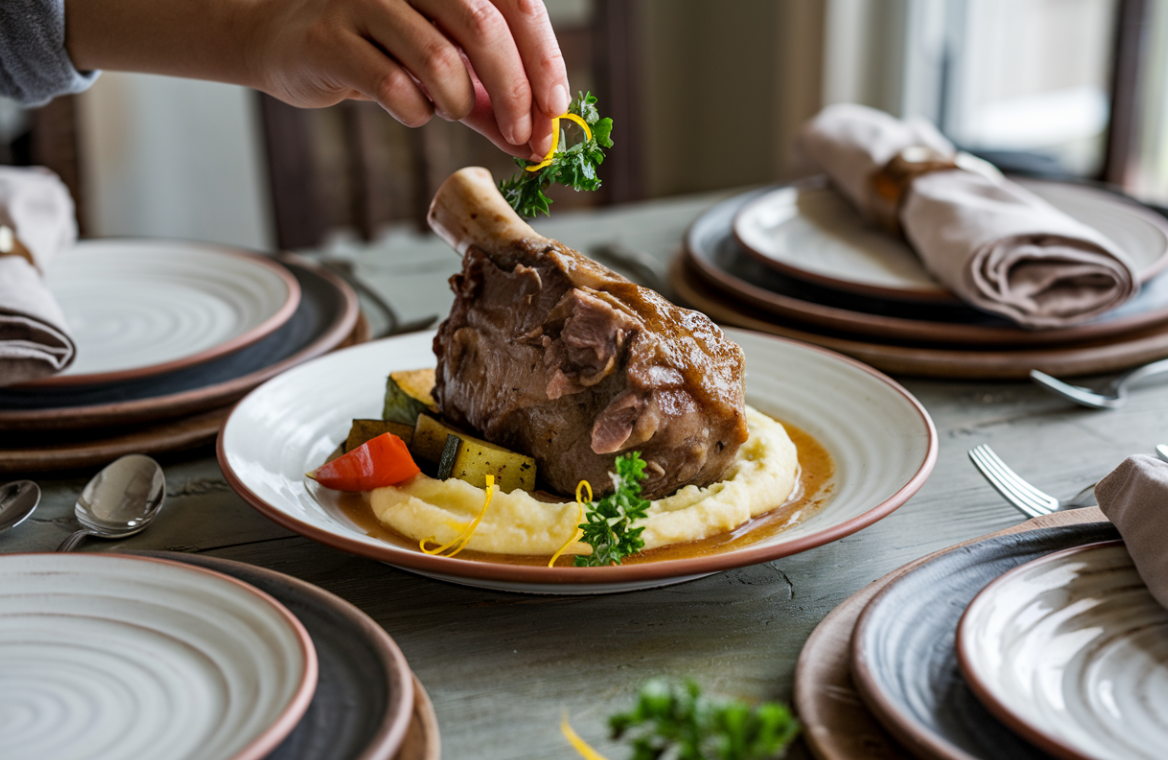Veal shank is a prized ingredient in the culinary world, known for its tender, flavorful meat, and remarkable versatility. Whether crafting a comforting stew or preparing a gourmet classic like osso buco, this cut delivers exceptional taste and nutrition. In this article, we’ll explore everything from choosing the perfect veal shank to preparing delectable recipes, ensuring you feel confident in mastering this exceptional cut of meat. So, let’s dive in and uncover what makes veal shank a standout ingredient.
Part 1: Introduction to Veal Shank
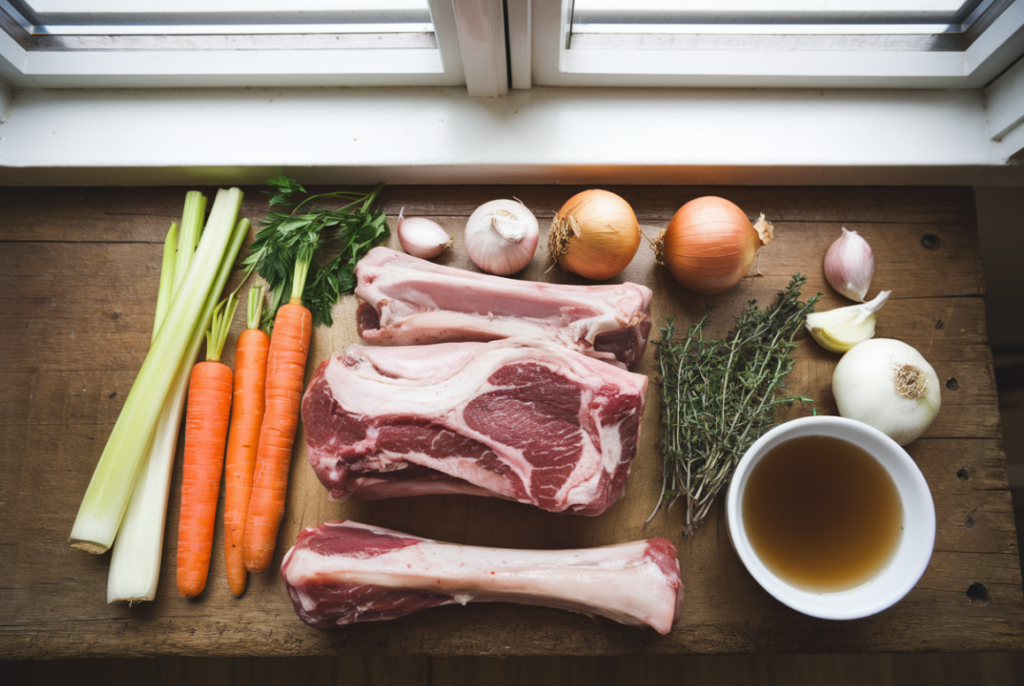
What is?
Veal shank is a cut of meat from the leg of a young calf, typically butchered with the bone intact. Known for its rich flavor and tenderness, it’s a favorite among chefs worldwide. The shank contains ample collagen, which breaks down during cooking, giving dishes a luxurious, melt-in-your-mouth texture. Commonly found in slow-cooked recipes, bone-in meat cuts stands out in classic dishes such as osso buco and hearty braises.
Nutritional Value of Braised veal
Packed with essential nutrients, veal shank is a great addition to a balanced diet. It’s a powerhouse of protein and minerals like iron, zinc, and phosphorus, supporting muscle repair and overall health. Unlike fattier cuts, it offers a leaner profile while still delivering deep, satisfying flavor. This makes veal shank a perfect choice for those seeking wholesome meals that don’t compromise on taste.
Why This Tender Cut is Popular?
Veal shank is celebrated for its versatility, as it adapts beautifully to various cooking methods, from braising to slow cooking. Its robust flavor profile enhances traditional recipes, while its nutritional content appeals to health-conscious cooks. Additionally, the bone-in cut contributes marrow to recipes, enriching broths and sauces with exceptional depth. Whether you’re a seasoned chef or a home cook, veal shank opens doors to culinary creativity.
Part 2: Cuts and Varieties of Veal Shank
Types of Osso buco Cuts
Veal shank comes in two primary forms, each suited to different culinary techniques. The fore shank, located near the front legs, tends to have more connective tissue, making it ideal for slow cooking. Meanwhile, the hind shank, cut from the rear legs, is larger and meatier, making it perfect for dishes where the meat shines as the centerpiece.
When choosing between bone-in or boneless options, the bone-in veal shank stands out. The marrow within the bone adds an unmistakable richness to soups, stews, and sauces, elevating the dish’s flavor profile. However, boneless shank offers convenience and is well-suited for recipes requiring uniform slices.
How to Choose the Best Bone-in meat cuts
Selecting high-quality veal shank is essential for achieving the best results. When buying, look for a cut with:
- Bright, pale pink meat, indicating freshness.
- Fine-grained texture and firm feel.
- A good amount of marbling, ensuring tenderness.
Additionally, the size of the bone matters. Larger bones contain more marrow, which can deepen the flavor of your dish. Always check the packaging date if purchasing from a store, or consult a butcher for the freshest options.
Seasonal Availability
While veal is generally available year-round, the freshness and sourcing may vary. Spring and early summer often bring a wider selection due to seasonal farming practices. Frozen veal shank is a reliable alternative, as it maintains quality and allows for flexibility in meal planning.
Whether you’re preparing an indulgent meal or trying a new recipe, understanding the types and qualities of veal shank ensures you start with the best foundation.
Part 3: Cooking Methods for Braised veal
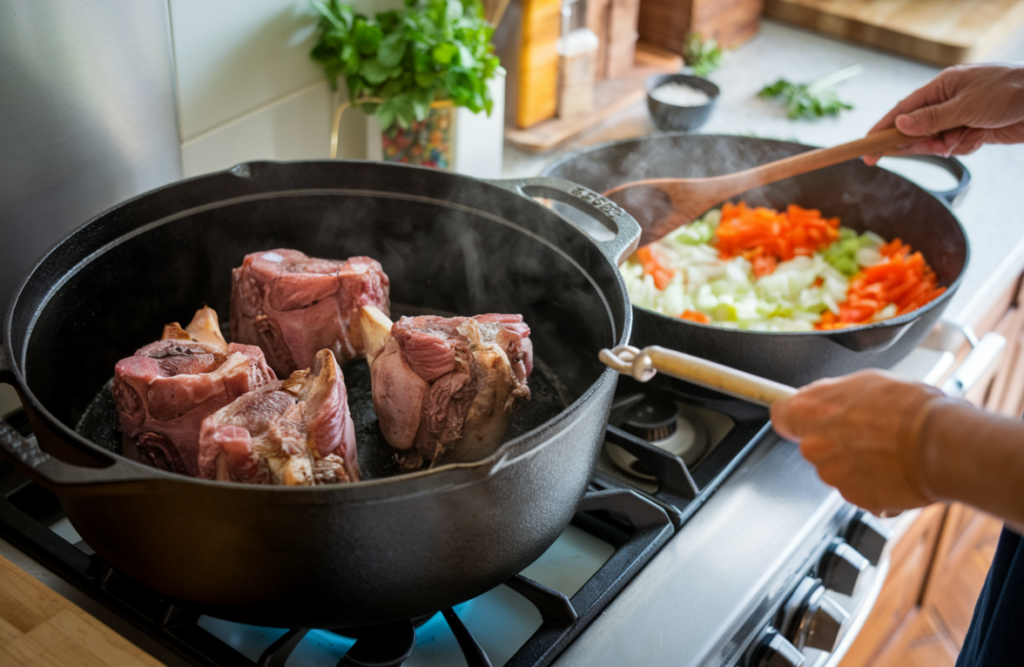
Preparing Veal Shank for Cooking
Before cooking Bone-in meat cuts, preparation is key to achieving optimal results. Start by rinsing the cut under cold water to remove any bone fragments or excess residue. Pat it dry with a clean towel, as a dry surface ensures better browning during cooking. If the recipe calls for seasoning beforehand, rub the shank with your chosen herbs, spices, and a light layer of olive oil. For marinades, allow the meat to rest for a few hours or overnight to maximize flavor infusion.
For even cooking, score the meat lightly around the bone. This prevents the shank from curling while cooking, especially in braised or roasted recipes.
Popular Cooking Methods
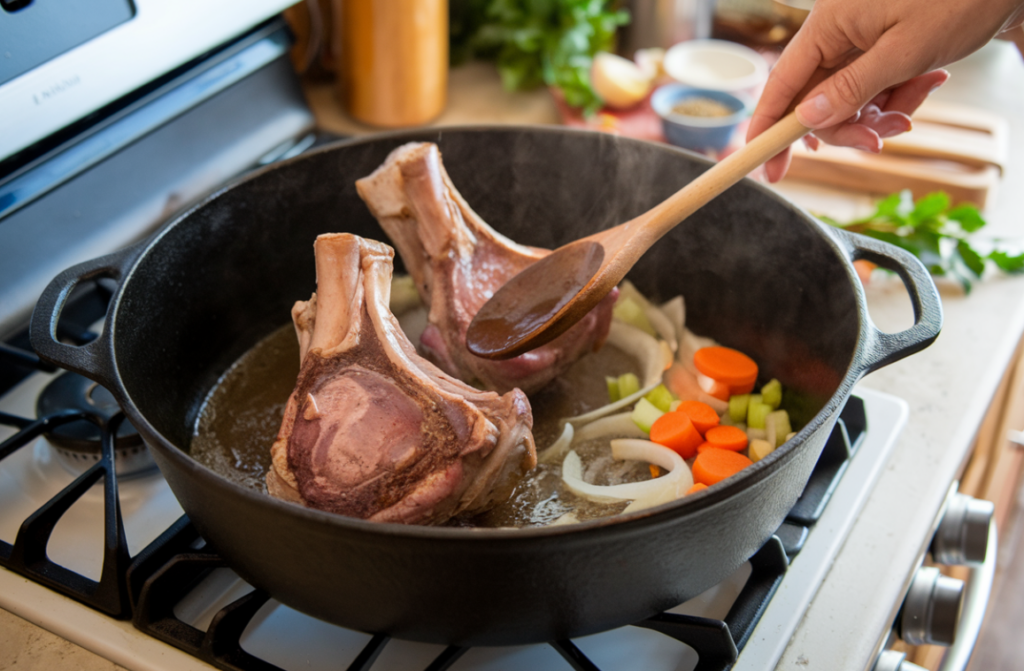
Braising Bone-in meat cuts
Braising is the gold standard for veal shank, transforming it into a tender, flavorful masterpiece. Here’s how to braise it perfectly:
- Ingredients: Aromatic vegetables like onions, carrots, celery; stock or broth; herbs like thyme and bay leaf; and optional tomato paste for depth.
- Method:
- Sear the veal shank on all sides in a heavy pot or Dutch oven until golden brown.
- Remove the shank and sauté the vegetables in the same pot until softened.
- Deglaze with a liquid like stock or water, scraping the browned bits for added flavor.
- Return the shank to the pot, add herbs, and cover with liquid.
- Cook on low heat or in the oven (at 325°F) for 2-3 hours until fork-tender.
Roasting Veal Shank
Roasting enhances the natural flavors of the veal while creating a caramelized crust.
- Preparation: Marinate the shank in your choice of seasoning blends. A simple mix of garlic, rosemary, and olive oil works wonders.
- Cooking: Place the shank on a roasting rack and cook at 375°F. Baste occasionally with its juices for a golden, flavorful exterior. Allow the meat to rest before slicing to lock in the juices.
Slow-Cooking Tender Cut
Slow cooking is a hands-off method that produces succulent, fall-apart meat.
- Method:
- Layer vegetables and herbs at the bottom of your slow cooker.
- Add the veal shank, followed by a liquid base like beef broth.
- Cook on low for 6-8 hours. The long cooking time allows the collagen to break down, enriching the sauce.
Grilling and Other Methods
Although less common, grilling veal shank provides a unique smoky flavor. Use indirect heat to cook it slowly, preventing the meat from drying out. Grilling works best for smaller, boneless cuts.
Common Mistakes to Avoid
Avoid these pitfalls when cooking veal shank to ensure success:
- Overcooking or undercooking: Slow methods like braising allow you to control doneness. Use a meat thermometer for precision.
- Skipping browning: Browning the shank before cooking adds depth to the dish.
- Neglecting resting time: Always let the cooked meat rest for a few minutes to redistribute juices.
With proper preparation and the right method, Braised veal transforms into a culinary delight that’s hard to beat.
Part 4: Best Recipes Featuring Bone-in meat cuts
Classic Braised veal Recipes
Osso Buco
Osso buco is a beloved Italian dish that showcases veal shank’s tenderness and rich flavor. Here’s how to prepare it:
Ingredients:
- 4 veal shanks (bone-in)
- 2 tbsp olive oil
- 1 onion, chopped
- 2 carrots, diced
- 2 celery stalks, diced
- 4 garlic cloves, minced
- 1 cup crushed tomatoes
- 2 cups beef broth or stock
- 1 tsp thyme
- 1 bay leaf
- 1 tbsp parsley, chopped (for garnish)
- Zest of 1 lemon (for garnish)
Method:
- Sear the Veal Shank: Season the veal shanks with salt and pepper. Heat olive oil in a Dutch oven over medium-high heat and brown the shanks on all sides. Remove and set aside.
- Prepare the Base: Add onions, carrots, celery, and garlic to the same pot. Sauté until softened and fragrant.
- Build the Sauce: Stir in the tomatoes and deglaze the pot with beef broth, scraping the bottom to lift browned bits. Add thyme and bay leaf for flavor.
- Braise: Return the veal shanks to the pot, ensuring they’re partially submerged in the liquid. Cover and simmer on low heat or in a 325°F oven for 2-3 hours, turning occasionally.
- Garnish and Serve: Sprinkle parsley and lemon zest over the cooked shanks before serving. Pair with risotto, polenta, or mashed potatoes for a hearty meal.
Veal Shank Stew
This hearty stew is perfect for chilly days.
Ingredients:
- 2 lbs Bone-in meat cuts, cut into pieces
- 1 tbsp olive oil
- 1 onion, diced
- 3 carrots, sliced
- 2 potatoes, cubed
- 1 cup green beans, trimmed
- 3 cups beef or vegetable stock
- 1 tbsp tomato paste
- 1 tsp paprika
- 1 tsp oregano
Method:
- Sear the Bone-in meat cuts pieces in olive oil until browned, then set aside.
- In the same pot, sauté onions, carrots, and potatoes until softened.
- Stir in tomato paste, paprika, and oregano. Add stock and bring to a simmer.
- Return the Osso buco to the pot and cover. Cook on low heat for 2 hours or until tender.
- Add green beans during the last 20 minutes of cooking. Serve warm with crusty bread.
Grilled Veal Shank
For a unique twist, try grilling veal shank.
Ingredients:
- 4 veal shanks (boneless, if possible)
- 3 tbsp olive oil
- 2 tbsp lemon juice
- 2 garlic cloves, minced
- 1 tsp rosemary
Method:
- Marinate the veal shanks in olive oil, lemon juice, garlic, and rosemary for 2 hours.
- Preheat the grill to medium heat.
- Grill the shanks over indirect heat, turning occasionally, for 25-30 minutes or until tender.
- Serve with grilled vegetables or a fresh salad.
Regional Specialties Using Veal Shank
Different regions have their own spin on veal shank:
- Italian: Osso buco with gremolata is a highlight.
- French: Try a slow-cooked veal shank stew with a creamy sauce.
- Middle Eastern: Spiced veal shank served over rice is a flavorful choice.
Pairing Veal Shank with Sides
Veal shank pairs wonderfully with creamy polenta, garlic mashed potatoes, roasted root vegetables, or even a simple green salad. Choose sides that complement its rich, hearty flavor for a balanced meal.
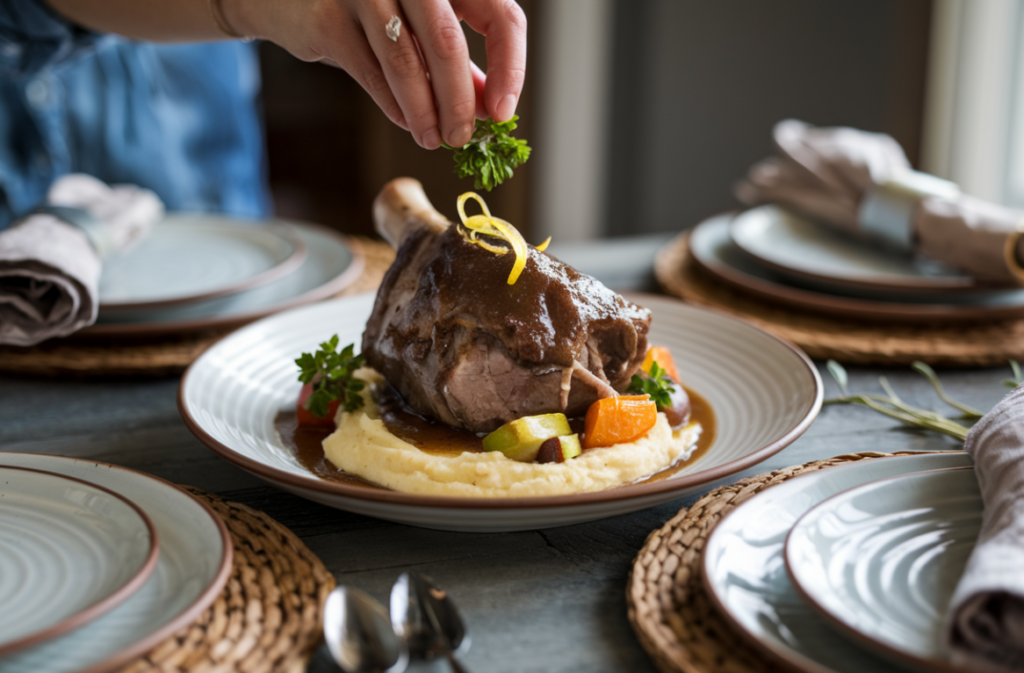
Part 5: Storing and Reheating Veal Shank
Proper Storage Techniques
Preserving the quality of veal shank begins with correct storage. If you’re not cooking it immediately, store raw veal shank in the refrigerator at a temperature below 40°F. It’s best to cook it within 2-3 days of purchase to maintain freshness. For longer storage, freezing is the way to go.
- Refrigeration Tips:
Wrap the veal shank tightly in butcher paper or plastic wrap to prevent air exposure. Place it on the coldest shelf of your refrigerator, not in the door where temperature fluctuates. - Freezing Tips:
For freezing, vacuum-seal the shank or wrap it in heavy-duty freezer bags to avoid freezer burn. Label it with the date to track storage time. Veal shank can remain frozen for up to 6 months without significant loss of quality. Before cooking, thaw it in the refrigerator overnight for best results.
Reheating Cooked Veal Shank
Reheating veal shank while preserving its tender texture and rich flavor requires gentle methods. Avoid using high heat, as it can dry out the meat. Here are the most effective ways:
- Oven Reheating:
- Preheat your oven to 300°F.
- Place the veal shank in a covered baking dish to trap moisture. Add a splash of broth or sauce to keep it juicy.
- Heat for 20-30 minutes, depending on the size of the shank.
- Stovetop Reheating:
- Use a heavy-bottomed pan or skillet over low heat.
- Add a small amount of liquid, like stock or water, to prevent sticking.
- Cover the pan and heat slowly, turning the shank occasionally.
- Microwave Method (Last Resort):
While not ideal, the microwave can work for smaller portions. Place the veal shank in a microwave-safe dish, cover it with a damp paper towel, and heat on low power in short intervals, checking frequently.
Tips for Reheating Success
- Always let the reach room temperature before reheating to ensure even warming.
- Reheat only the portion you plan to consume, as repeated reheating can degrade texture and flavor.
By storing and reheating veal shank properly, you can enjoy its deliciousness in multiple meals without compromising quality.
Part 6: Health Benefits and Considerations
Benefits of Including Veal Shank in Your Diet
Veal shank isn’t just a culinary delight—it’s also a powerhouse of nutrition. Here’s why it deserves a place on your plate:
- High-Quality Protein: Veal shank is rich in protein, which is essential for muscle repair, growth, and overall bodily functions. A single serving can help meet daily protein requirements.
- Rich in Micronutrients: This cut is packed with iron, phosphorus, and zinc. These minerals play a crucial role in boosting energy, supporting bone health, and strengthening the immune system.
- Low in Fat: Compared to fattier cuts of meat, veal shank offers a leaner profile while still providing hearty flavor. This makes it an excellent choice for health-conscious individuals.
- Collagen-Rich Bone Marrow: The bone-in cut adds an extra nutritional bonus. Bone marrow contains collagen, which supports joint health, skin elasticity, and gut health.
Adding veal shank to your diet is a simple way to enjoy a nutrient-dense meal that satisfies both the palate and the body’s nutritional needs.
Potential Health Concerns
While veal shank has numerous benefits, it’s important to be mindful of the following considerations:
- Saturated Fat Content: Though veal shank is relatively lean, the presence of saturated fats may be a concern for individuals monitoring heart health. Pairing it with fiber-rich sides like vegetables can balance the meal.
- Cholesterol Levels: As with most meats, veal contains cholesterol. Moderation is key, especially for those with dietary restrictions related to cholesterol.
- Ethical Concerns: For some, the ethical aspects of consuming veal might be a factor. Opting for ethically sourced, pasture-raised veal from reputable suppliers can address these concerns.
Balancing Taste and Health
Veal shank is a fantastic addition to a balanced diet when prepared thoughtfully. Combine it with nutritious sides like roasted vegetables, quinoa, or whole-grain dishes to create a meal that supports your health goals without sacrificing flavor.
Part 7: FAQs About Veal Shank
What Does Veal Shank Taste Like?
Veal shank has a delicate, mild flavor that pairs beautifully with rich sauces and aromatic spices. When cooked properly, the meat becomes tender and juicy, and the bone marrow adds an extra layer of savory richness.
How Long Does It Take to Cook Veal Shank?
The cooking time depends on the method you choose. For example, braising veal shank typically takes 2-3 hours, while slow cooking may require 6-8 hours. Roasting or grilling usually takes less time but depends on the thickness of the cut. Always ensure the meat reaches the desired tenderness.
Can I Substitute Veal Shank with Another Meat?
Absolutely! Lamb shank or beef shank are excellent substitutes, as they offer similar texture and flavor when prepared in the same way. However, keep in mind that each meat has its own unique taste, which might slightly alter the final dish.
Is Veal Shank Expensive?
While veal shank can be pricier than some other cuts of meat, its exceptional flavor and versatility make it a worthwhile investment. Prices can vary based on location, quality, and whether it’s bone-in or boneless.
What’s the Difference Between Veal Shank and Lamb Shank?
The primary difference lies in the flavor. Veal shank has a milder taste, while lamb shank is more robust and gamey. Both cuts are rich in collagen, making them ideal for slow-cooked recipes.
Where Can I Buy High-Quality Veal Shank?
High-quality veal shank is typically available at butcher shops, specialty meat markets, or online retailers. Look for ethically sourced and pasture-raised veal to ensure the best quality and flavor.
Conclusion: Why Veal Shank is a Culinary Treasure
In conclusion, veal shank stands out as a truly versatile and flavorful cut of meat that every cook should explore. From its nutritional benefits to its wide-ranging culinary applications, it offers something for everyone, whether you’re preparing a comforting stew or a gourmet dish like osso buco.
Moreover, learning how to choose, cook, and store veal shank ensures you get the most out of this exquisite ingredient. With its rich taste, tender texture, and healthful properties, veal shank is a culinary treasure worth savoring.
So, why wait? Dive into the world of veal shank, experiment with new recipes, and enjoy its incredible versatility. Trust us—once you’ve mastered cooking this cut, it’ll quickly become a favorite in your kitchen!
